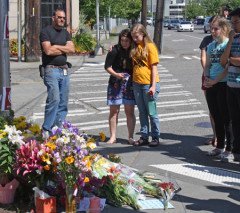Shooting at SPU, Ross and the Streetcar Barn
The scourge of campus shootings came to Queen Anne on June 5, 2014 when 26-year-old Aaron Ybarra opened fire in Otto Miller Hall. Ybarra wounded three students -- one of whom, 19-year-old Paul Lee, died. Ybarra was subdued with pepper spray as he tried to reload his gun by 22-year-old SPU student Jon Meis, who restrained him until the arrival of Seattle Police. Meis was treated at the hospital and later released, along with another victim, Thomas Fowler, 24, who suffered pellet wounds to his chest and neck. The third victim, Sarah Williams, 19, was hospitalized after suffering wounds to her abdomen.
The tragic event at Seattle Pacific University astounded Queen Anne residents. The Christian university maintains a generally quiet and peaceful place in the community’s mind. The school’s low profile hides the fact that it is one of Seattle’s oldest institutions of higher learning -- established in 1891. SPU is typical of so many seminaries associated with a church and established for the elementary education of congregation children. In fact, Nils Peterson, a member of the Free Methodist Church with which the university is still associated, donated the land for the school as a place for his children. Today Peterson’s farm, which originally tumbled down the northern side of Queen Anne, is mostly intact and now known as Mount Pleasant Cemetery.
It may surprise Queen Anne residents to learn that Otto Miller Hall, the site of the June 5, 2014 shooting, is actually a significantly remodeled building that from 1912 on played a serious role in the history of Ross and public transit in Seattle. Ross was the little town or nascent neighborhood at the base of Third Avenue West on the Outlet, the little stream that drained Lake Union to Salmon Bay. In 1912, Seattle completed the first leg of the city-owned Municipal Railway. It ran over Dexter Avenue from downtown and headed west on Nickerson from the Fremont Bridge to a turnaround at 13th Avenue West. It is no wonder Nickerson is such a wide street.
As part of the streetcar line, the city constructed a barn for the cars south of the tracks of the Seattle, Lake Shore and Eastern Railroad that ran on what is now the Ship Canal Trail. The streetcar line itself ran out to 13th Avenue West where folks could walk over to the line crossing Salmon Bay and catch anther car to Ballard. The municipal railway located the car barn here just off what they called Ross Station. Quite amazingly, Otto Miller Hall is the very same yet extensively remodeled streetcar barn. The alterations to the barn were the work of architect Robert Durham, whose firm designed many SPU buildings.
There is no point to retell here the history of the little town of Ross. The importance of remembering Jon Meis’s heroism and the horror that has erupted nationwide as guns fall into the hands of emotionally needy people like Aaron Ybarra is that these stories must become permanent parts of our local record. We must never forget our heroes and always remember the sometimes sad perpetrators into whose untrustworthy hands guns much too often tragically fall.



